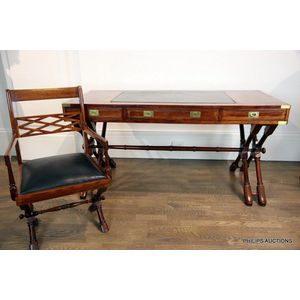Mahogany Campaign Desk and Chair Set
A stretcher-based mahogany campaign style desk and chair, 20th century, with leather insert, three drawers with recessed brass handles, corner, strapping and stringing, pairs of X - form leg bases united by a turned, stretcher, the conforming chair with a straight cresting rail, trellis mid, rail and leather seat, height 76 cm, length 153 cm, width 71 cm (desk)
You must be a subscriber, and be logged in to view price and dealer details.
Subscribe Now to view actual auction price for this item
When you subscribe, you have the option of setting the currency in which to display prices to $Au, $US, $NZ or Stg.
This item has been sold, and the description, image and price are for reference purposes only.
- Campaign Furniture - Most of the campaign furniture on the market is associated with the time of the British Empire in the 18th and 19th centuries when there was a high demand from military officers, administrators and colonists.
Campaign furniture is demountable, through clever use of wooden screws and sometimes metal hinges, so that it can disassembled and then packed into lots of manageable size for ease of movement by ship or animal between postings or camps. - Stretcher - A horizontal rail which connects the legs of stools, chairs, tables and stands, to provide stabilisation of the legs. A stretcher table is any table with a stretcher base. The term is usually applied to substantial farmhouse tables, although many cabinetmaker's pieces, such as sofa tables, also have turned stretchers.
- Turning - Any part of a piece of furniture that has been turned and shaped with chisels on a lathe. Turned sections include legs, columns, feet, finials, pedestals, stretchers, spindles etc. There have been many varieties and fashions over the centuries: baluster, melon, barley-sugar, bobbin, cotton-reel, rope-twist, and so on. Split turning implies a turned section that has been cut in half lengthwise and applied to a cabinet front as a false decorative support.
- Cresting - The decorative carving at the top of a piece of furniture, such as a sideboard back, a mirror, or a chair back.
- Rail - A term used by cabinet makers for the horizontal sections of the frame of an item such as a chair or settee which have a front rail, a back rail and two side rails, and also on a door or carcase, where the rails are joined to the vertical framings.
- Stringing - Fine inlaid lines, in contrasting colour to the carcase timber, found mainly on furniture made in the styles of the later 18th and early 19th centuries. Stringing, which may be of satinwood, pine, ebony, horn, brass or occasionally ivory, is found principally on drawer fronts, around the outer edges of usually tapered legs and French bracket feet, around the edges of inlaid panels and between the joint of the cross banding and carcase timber on table tops, chests of drawers, cabinets etc. The effect is to emphasize the line of the piece and add to the impression of lightness and elegance. Stringing also occurs in Sheraton-revival-style furniture of the later 19th and early 20th centuries.
- Mahogany - Mahogany is a dense, close grained red-coloured timber from the West Indies and Central America. It was first imported into Europe in the the early 18th century and its use continued through the 19th century. It was popular for furniture making because of its strength, the wide boards available, the distinctive grain on some boards, termed flame mahogany and the rich warm colour of the timber when it was polished.. The "flame" was produced where a limb grew out from the trunk of the tree, and this timber was usually sliced into veneers for feature panels on doors, backs and cornices.
Some terms used to describe mahogany relate to the country from which it originally came, such as "Cuban" mahogany, "Honduras" mahogany etc. However unless the wood has been tested the names assigned are more a selling feature, rather than a true indication of the timber's origin.
This item has been included into following indexes:
-
chairs, singles / pairs / threes, style or period
- campaign and military 20
- desk 293
- library 293
- office 293
- chairs, singles / pairs / threes, timber - mahogany 1,120
Visually similar items

Antique extension dining table on turned legs original brass casters with winder, measures 1.7m long x 1.2m w x 76 cm high
Sold by
in
for
You can display prices in $Au, $US, $NZ or Stg.

Hall chairs. Pair of late 19th century Continental Empire style mahogany
Sold by
in
for
You can display prices in $Au, $US, $NZ or Stg.

Antique pine washstand, approx. 76 cm x 92 cm
Sold by
in
for
You can display prices in $Au, $US, $NZ or Stg.

Edwardian hexagonal top with spindles occasional table
Sold by
in
for
You can display prices in $Au, $US, $NZ or Stg.
